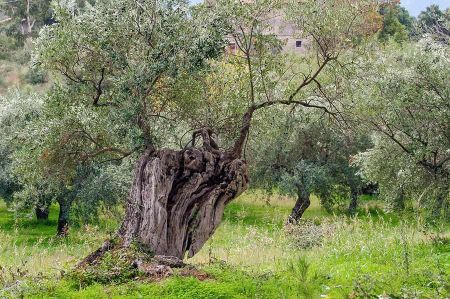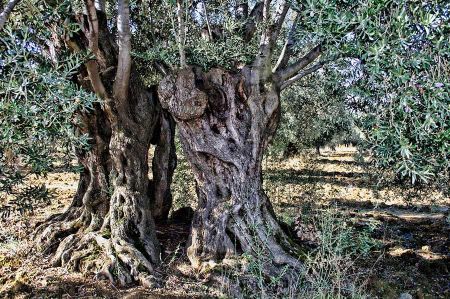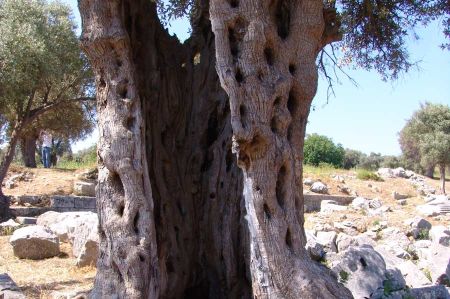Olive trees - cultural-historical examination of the olive tree
- Written by Portal Editor
During our return journey from Istanbul via the Dardanelles towards Izmir, we also passed the region around the tourist town of Ayvalik. Like almost everywhere in Turkey, the construction industry is booming here and this is why there is often serious clear-cutting in nature, even if it "only" consists of huge groves of thousands of olive trees.
Ayvalik is one of the centres of Turkish olive plantations, famous for excellent quality virgin olive oil, which is so healthy due to its ingredients. Most of the groves still exist, covering areas up to the horizon and drawing the eye to the always green, sometimes ancient trees as you drive past.
Olive trees that are well over 9,000 years old


“But Atreid, drawing his sword full of silver humps, jumped up to Peisandros. He raised the shining battle-axe under his shield, the honourable one, adorned with the handle of an olive tree, beautifully smoothed and long; and they pressed against each other at the same time.”
(Homer: Iliad, Canto 13, 610–613)
“Within the enclosure there was an olive tree that shaded widely, strong and blooming; the trunk resembled pillars in thickness. I built it all around it with densely arranged stones, our marriage chamber, and arched the upper ceiling and closed the gate with tightly fitting wings. Then I cut off the branches of the olive tree that shaded me far and hewed the trunk at the root, smoothing it artificially and beautifully all around with the bronze and according to the measure of the rule; carved it at the foot of the bed, and drilled it all around with the drill, added planks to it, and built the graceful bed, which was decorated with gold and silver and ivory and ran through it with straps of purple bull skin.
(Odyssey, Canto 23, 190–201)
The mentions in the Bible also point to the great importance of the olive tree:
“Once upon a time the trees arose to anoint themselves a king, and they said to the olive tree, 'Be our king.' The olive tree said to them, 'Shall I give up my fat, which is used to honor gods and men, and go 'to sway above the other trees?'” (Book of Judges, 9:8-9)
“Towards evening the dove came back to him, and lo and behold, it had a fresh olive branch in its beak. Now Noah knew that there was little water left on the earth.” (Genesis, 8, 11)
There are also comparable, interpretable records of the importance of the olive tree in the Koran:
“And it is He who sends water down from heaven; with it we produce all kinds of plants; … and olive and pomegranate (trees) …” (The approximate meaning of Al-Qur’an Al-Karim, Sura 6:99 “The Cattle”).
“Allah is the Light of the heavens and the earth. Its light is like a niche in which there is a lamp: The lamp... Lighted (the lamp is) by a blessed olive tree, which is neither east nor west, whose oil would almost glow even if the fire did not touch it. (The approximate meaning of Al-Qur'an Al-Karim, Sura 24:35 "The Light").
“Then We divided the earth miraculously and caused corn to grow in it... and olive trees...” (The approximate meaning of Al-Qur'an Al-Karim, Sura 80:26-29 "He frowned").
In the 6th century B.C. The olive tree also came to Italy in the 4th century BC. As in Greece, a wreath made of olive branches was the highest honour of the citizen who had done a great job for the fatherland, as well as the highest prize (wreath made of branches from the kotinos kallistephanos) at the Olympic Games. The olive branch was the symbol of peace, and conquered people who asked for peace carried olive branches in their hands.
In the early Byzantine period, the export of olive oil was the economic basis for its heyday from the 4th century onwards, as the olive tree grew in all areas around the Mediterranean and partly also around the Black Sea when extreme climatic conditions did not occur. It can endure extreme heat, but suffers easily from frost in cold winters, which threatens not only the harvest of individual years but the existence of entire plantations. It is therefore also considered a character plant of the Mediterranean flora.
Please read as well:
Old Doganbey Village • Domatia
Mantı - Turkish pasta pockets with yogurt
https://www.alaturka.info/en/life/flora/6334-olive-trees-cultural-historical-examination-of-the-olive-tree/amp#sigProIdbf9f5a1daa
